For years, ‘AI copywriter’ was a joke. We all saw the robotic, soulless nonsense it produced.
We laughed. We felt safe.
Well, it’s October 2025. Stop laughing.
While we were all patting ourselves on the back for being ‘creative,’ the AI was in the gym.
It analyzed billions of winning (and losing) ads. It learned persuasion, psychology, and platform nuance.
And now? In 2025, McKinsey, Google, and various marketing analytics firms show that:
“Ad campaigns using AI for copy generation, A/B testing, and audience personalization see significant performance lifts (higher click-through rates, better conversion rates, and improved return on ad spend) compared to human-only counterparts.”
I wouldn’t say it’s a gimmick anymore. It’s a genuine competitor if you stay as an average copywriter.
Or, if you’re smart, it’s the most powerful creative partner you’ve ever had. This is your wake-up call.
Table of Contents
| Sections | Key Findings |
| Why AI Is Beating Humans in Ad Copy | AI isn’t just creative; it’s data-driven, blending billions of data points with persuasion. |
| Way #1: Psychology & Data | AI analyzes billions of ads instantly, finding emotional triggers and keywords that humans miss. |
| Way #2: Hyper-Personalization at Scale | AI crafts dozens of unique ad variations for micro-audiences, something no human team can do. |
| Way #3: A/B Testing Built-In | AI generates endless variations of headlines and CTAs in seconds, finding the winner faster. |
| Way #4: Eliminates Writer’s Block | AI provides endless angles, hooks, and ideas, destroying creative fatigue. |
| Way #5: Platform-Specific Optimization | AI tailors copy to the unspoken rules and formats of Google, TikTok, and LinkedIn. |
| Way #6: Continuous Learning | AI gets smarter with every click, learning exactly what your specific audience responds to. |
| Does AI Replace Copywriters? | The honest truth is that AI needs a human strategist to direct it. It’s a co-pilot, not a pilot. |
| Best AI Ad Copy Tools | A new generation of AI tools is built specifically for high-converting ad copy. |
| How to Use AI (5-Step Guide) | A simple 5-step workflow shows you how to integrate AI into your creative process. |
Why AI Is Now Beating Humans in Ad Copywriting
This shift didn’t happen overnight. It’s the result of AI moving from a simple “auto-complete” parlor trick to a true data-driven creative partner.
For years, we creatives have relied on a mix of experience, intuition, and caffeine. We still need all three, but the game has a new variable.
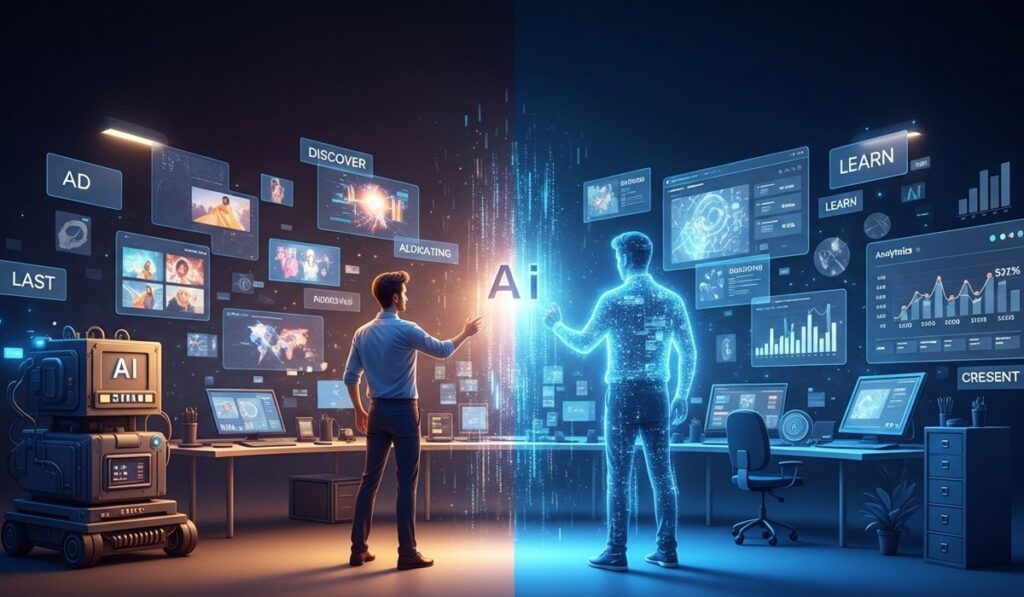
Evolution of AI Marketing Tools
The early tools were clunky. They could string words together, but they had no soul, no rhythm.
Today’s platforms are trained on massive datasets of what actually works—
- What headlines get clicks?
- What CTAs drive sales?
- What emotional language triggers a response?
Data-Driven Creativity Is The New Advantage
Creativity used to be a black box. Now, data is shining a light inside.
AI can analyze a million ads and tell you that using the word “discover” instead of “learn” increases click-through rates by 7% for a specific audience.
That’s a statistical reality. It gives our creative choices a data-backed edge we’ve never had before.
AI Vs Human Copywriting — Not A Competition But A Collaboration
The fear is that AI is coming for our jobs. The reality is that it’s coming for the boring parts of our jobs.
It’s here to kill the grunt work, not the genius. The winning strategy is figuring out how to combine AI and human creativity for better ads.
Way #1 – AI Uses Psychology And Data To Boost Conversions
Your human intuition is based on your life experience—maybe a few decades of it.
AI’s “intuition” is based on the collective experience of nearly every ad ever run on the internet. It sees patterns we simply can’t.
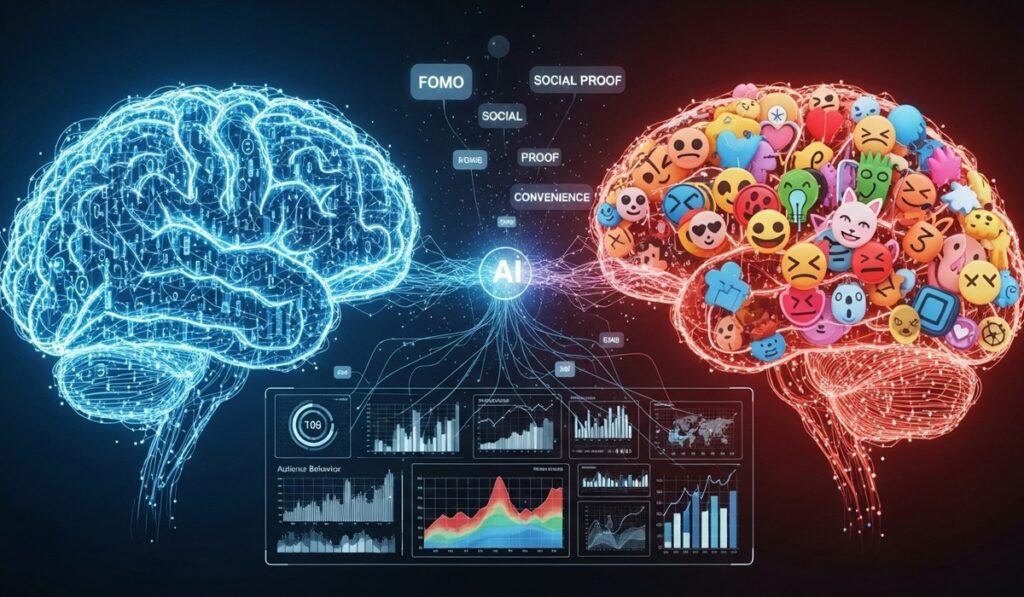
Predictive Keyword And Emotional Trigger Optimization
An AI can scan your target audience’s online behavior, identify the language they use, and pinpoint the emotional triggers that correlate with conversion.
It knows if your audience is driven by FOMO (fear of missing out), social proof, or a desire for convenience.
And it will weave that psychological trigger right into the copy.
AI Learns From Billions Of Ads Instantly
Before you’ve finished your morning coffee, an AI can analyze the top-performing ads in your niche from the last 24 hours and extract the core messaging elements.
It’s like having a team of a thousand research interns working around the clock. This is exactly how AI predicts your next winning ad before you launch it.
Hidden Power Of Persuasion Models In AI Tools
The best AI tools have classic copywriting frameworks baked into their DNA, like:
- AIDA (Attention, Interest, Desire, Action)
- PAS (Problem, Agitate, Solve).
They construct arguments in sentences designed to persuade, based on models proven over decades.
Way #2 – AI Creates Hyper-Personalized Ad Copy At Scale
You might be able to write 3-4 good variations of an ad. An AI can write 300, each one tailored to a different micro-audience, without breaking a sweat.
This is hyper-personalization, and it’s something no human team can realistically achieve.
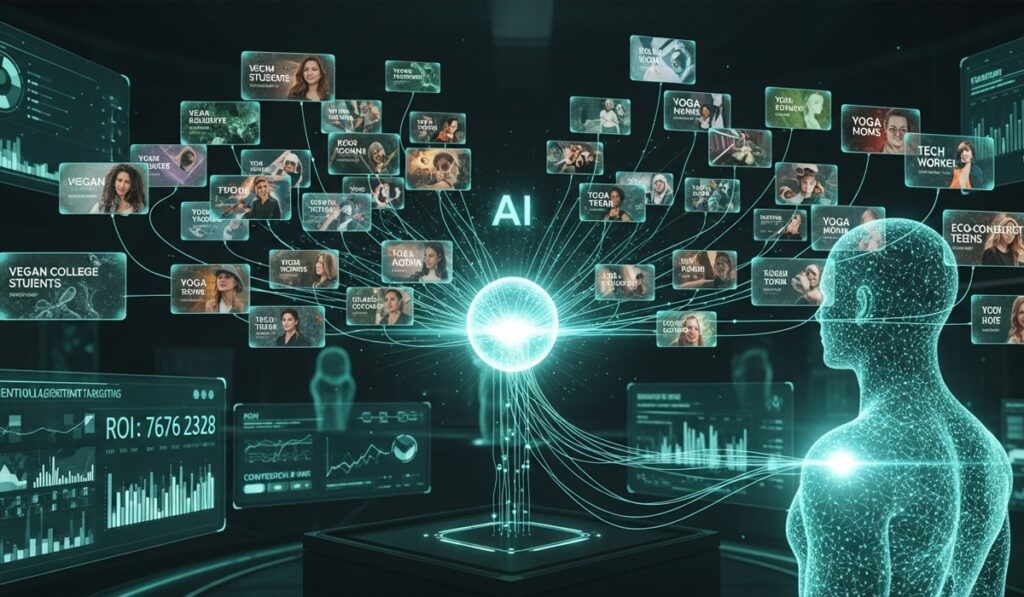
Dynamic Audience Segmentation And Personalization
Imagine you’re selling eco-friendly sneakers. A human might write one ad for “environmentally conscious shoppers.”
An AI can write a version for “vegan college students in California,” another for “moms over 40 who practice yoga,” and another for “tech workers who bike to work.”
Each ad uses slightly different language, hooks, and benefits. This is one of the core AI strategies to boost Facebook Ads ROI.
AI Crafts Messaging For Multiple Customer Personas
Your core message—”comfortable, sustainable shoes”—doesn’t change.
But how you frame it does.
For the student, the AI might focus on style and affordability.
For the mom, it might highlight durability and comfort.
It creates these nuanced variations instantly. Pair that copy with a custom visual from an AI Art Generator, and you have a truly personalized ad.
Real Example: Personalized Ad Variations For 10+ Segments
We recently worked with an e-commerce client who had 12 distinct customer personas.
Manually creating copy for each was a nightmare. We fed the core product details and personas into an AI.
Results: In under an hour, we had unique, high-quality copy for all 12, plus three variations for each. The resulting campaign saw a 22% lift in conversion.
Way #3 – AI Writes Faster With A/B Testing Built In
The creative part of your brain and the analytical part are separate. AI combines them. It writes 20 headlines and simultaneously analyzes which one is most likely to win based on past performance data.
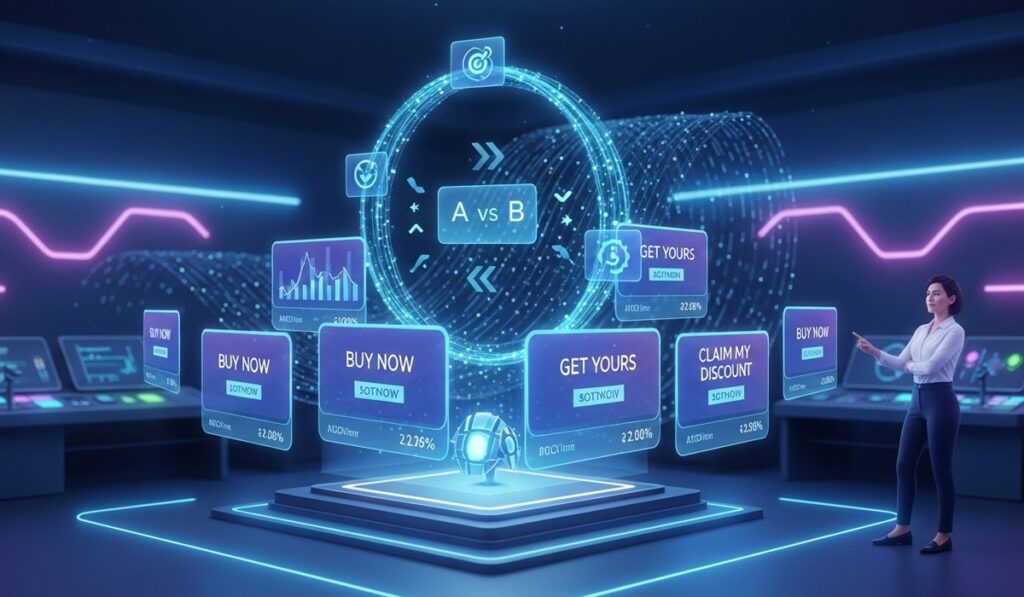
Endless Headline And CTA Variations In Seconds
“Buy Now,” “Shop Today,” “Get Yours,” “Claim My Discount.” Which one works best?
A human has to write them all out and set up a meticulous test.
An AI generates dozens of options in seconds and can even suggest which ones to prioritize, helping you turn low-performing ads into profit.
Auto A/B Testing To Identify Winning Copy
The workflow is completely transformed. Instead of:
- writing, launching, waiting, and then analyzing,
You generate, get a data-driven prediction, and launch with a much higher degree of confidence.
The testing phase becomes exponentially faster.
Real-Time Feedback Loop Improves Future Campaigns
The AI learns from every test.
When variation B beats variation A, that data is fed back into the system, making its next set of suggestions even smarter.
Your campaigns evolve over time.
Way #4 – AI Eliminates Writer’s Block And Creative Fatigue
This is my personal favorite. That 3 PM feeling when you’re staring at a blank page, and the cursor is just blinking, mocking you? It’s gone. Forever.
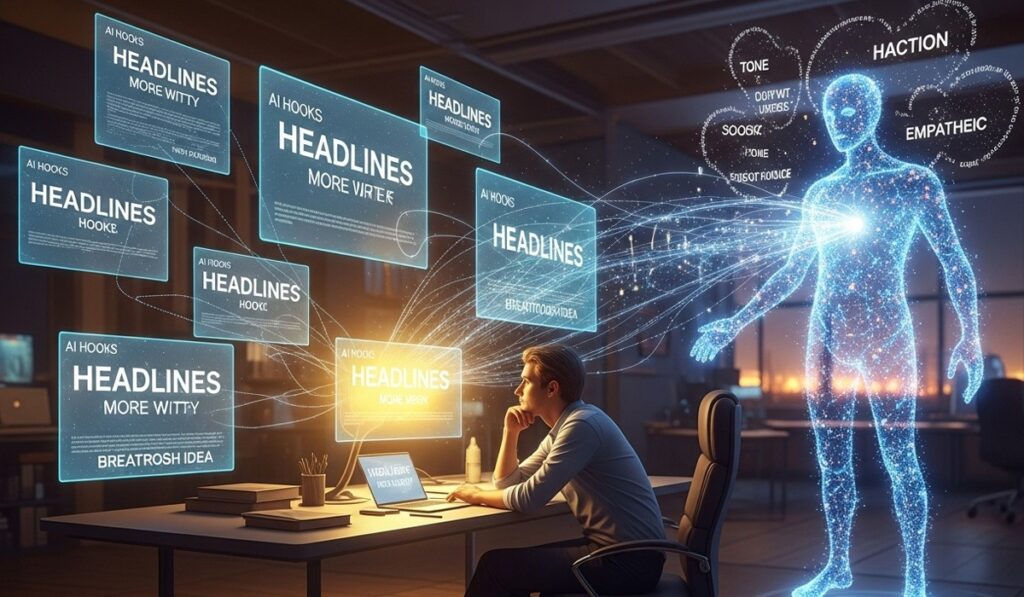
Idea Generation For Headlines, Hooks, Angles
Stuck for a new angle on a boring product? Feed the product description to an AI and ask for “10 surprising hooks.”
Nine might be duds, but one will be gold. It’s the ultimate creative spark plug.
AI Rewrites Copy For Tone, Clarity, Emotion
Ask an AI to rewrite your copy to be “more witty,” “more urgent,” or “more empathetic.”
It can instantly re-skin your ideas in different emotional tones, saving you hours of frustrating wordsmithing.
Time-Saving Workflows For Agencies And Marketers
For agencies, this is a game-changer. The time once spent on endless, low-level copy variations can now be reallocated to high-level strategy, client relationships, and bigger creative swings.
Way #5 – AI Optimizes Copy For Every Platform And Goal
A great ad for TikTok is a terrible ad for Google. A human has to re-learn each platform’s “vibe” and unspoken rules. AI already knows.
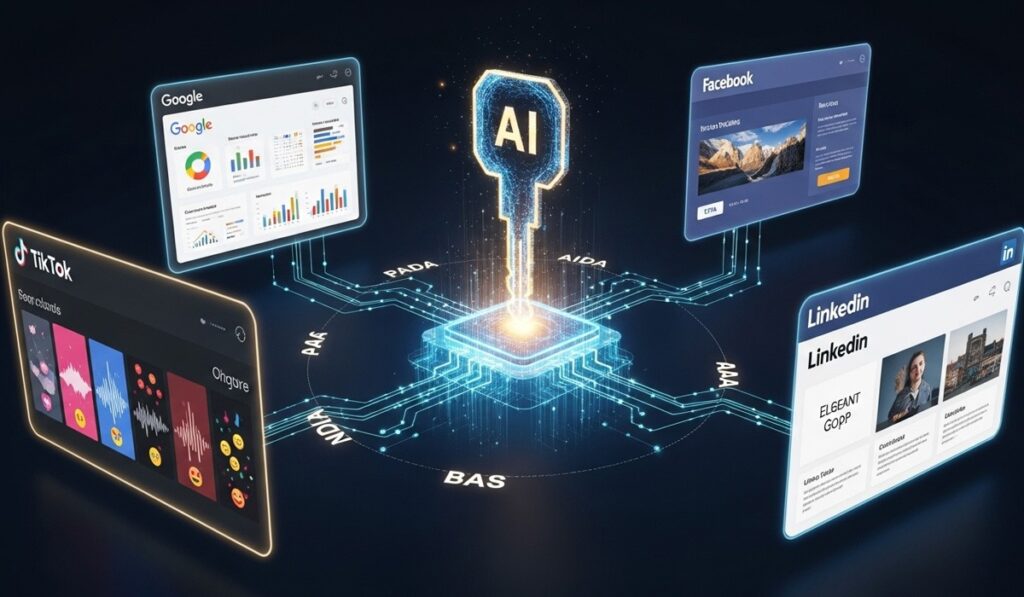
Platform-Specific Ads (Google, Facebook, Tiktok, Linkedin)
AI tools trained on platform-specific data know that LinkedIn copy needs to be professional and value-driven, while TikTok copy needs to be short, punchy, and use trending audio cues.
It changes the entire approach to match the user’s mindset on that platform. This is critical when you need to write the perfect script for AI video generation.
Conversion-Focused Frameworks (PAS, AIDA, 4CS, BAB)
Need a Google Ad? The AI will lean into a clear, concise Problem-Agitate-Solve framework.
Need a Facebook Ad to drive sales? It might use Before-After-Bridge. It applies the right tool for the job automatically.
With a suite of tools like an AI Video Generator and AI Graphics Design, you can create fully optimized assets in a fraction of the time.
Multilingual Ad Generation For Global Scale
Want to launch your campaign in Germany and Japan?
A human would need a translation team and a localization expert.
An AI can generate culturally-aware, high-quality ad copy in dozens of languages in minutes, giving you instant global reach.
Way #6 – AI Continuously Learns What Your Audience Responds To
This is the most terrifying and powerful part. Your ads learn while running live. Every click, every impression, every conversion becomes a data point that makes the next ad smarter.
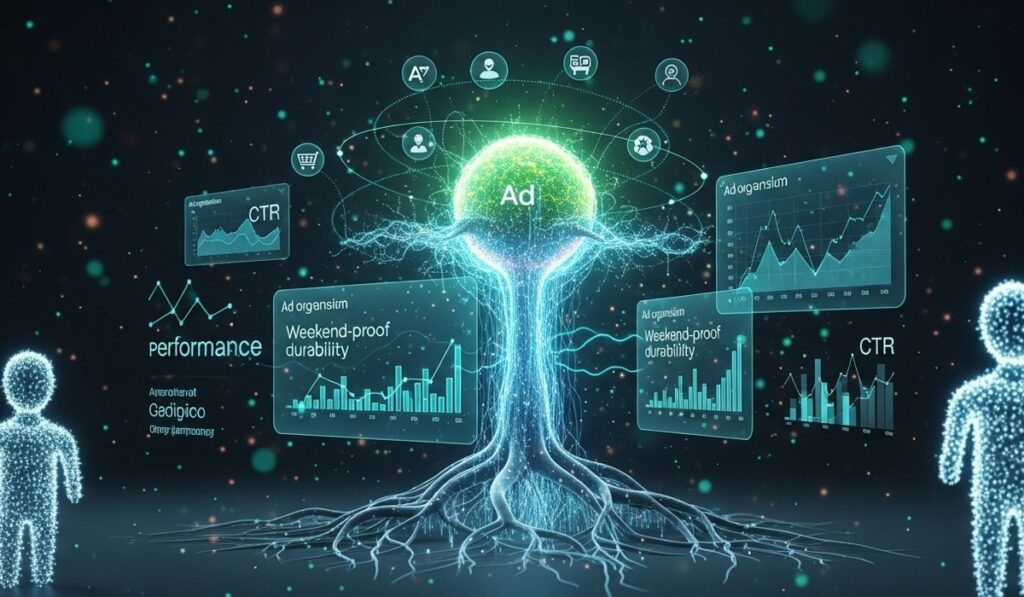
Performance-Driven Learning Over Time
By integrating with your ad manager, the AI can see which ads are performing and why.
It doesn’t just see that Ad #3 won; it sees that the phrase “weekend-proof durability” in Ad #3 was the key variable. It then uses that insight in future generations.
Behavioral Targeting From Customer Interaction Data
The AI analyzes who is clicking and converting. It learns that your best customers are people who also follow certain influencers or have specific hobbies.
This refines its understanding of your audience, making the copy even more targeted over time.
Why AI-written Ads Get Cheaper Clicks Over Time
Better copy leads to higher relevance scores.
Higher relevance scores lead to lower cost-per-click (CPC) and cost-per-acquisition (CPA).
The AI’s continuous learning creates a virtuous cycle: the ads get better, the targeting gets sharper, and your budget goes further.
Does AI Replace Copywriters? The Honest Truth
So, am I out of a job? No. But my job has fundamentally changed. AI is a world-class assistant, but it’s a terrible strategist.
It can write a hundred lines of copy, but it can’t tell you which one truly aligns with your brand’s five-year vision.

AI Needs Strategic Human Direction
You still need a human to
- set the goal,
- define the brand voice,
- understand the customer’s deepest needs, and
- have that “aha!” moment that defines a great campaign.
The AI is the tool; you are the architect.
Human Creativity + AI Efficiency = Best Results
The best work I’m seeing in 2025 isn’t “AI copy” or “human copy.” It’s a hybrid copy.
A human provides the core concept and the final polish, while the AI does the heavy lifting of variation, testing, and optimization.
When To Use AI and When To Write Manually
Use AI for performance marketing: Google Ads, social media ads, email subject lines, product descriptions.
Use a human for brand-level communication: your company’s mission statement, a brand manifesto video, the tagline for your Super Bowl spot.
Best AI Tools for Writing High-Converting Ad Copy
Not all AI is created equal. Some are for writing long-form blogs, but others are precision-engineered for one purpose: conversion.
Top AI Ad Copy Tools (Jasper, Copy.Ai, ChatGPT, Writesonic)
These are the heavy hitters as of late 2025.
- Jasper (formerly Jarvis) is known for its robust templates and brand voice features.
- Copy.ai is incredibly user-friendly for beginners.
- ChatGPT remains the versatile Swiss Army knife.
- And Writesonic has a strong focus on landing pages and Google Ads copy.
Pricing And Features Comparison
| Tool | Starting Price (Oct 2025) | Best For | Key Feature |
| Jasper | ~$59/mo | Teams & Agencies | Brand Voice & Recipes |
| Copy.ai | ~$49/mo | Solo Marketers | Simplicity & Workflow |
| ChatGPT | ~$20/mo (Plus) | General Purpose | Flexibility & Power |
| Writesonic | ~$30/mo | Performance Marketers | SEO & Landing Pages |
Which Tool Is Best For Your Business?
If you’re a large team needing brand consistency, Jasper is a solid bet.
If you’re a freelancer or small business owner, Copy.ai or Writesonic might be a better starting point.
And if you’re already using AI for other tasks, building on ChatGPT is a smart move.
How To Use AI To Write Ad Copy In 5 Simple Steps
This is the exact workflow I use. It’s simple, and it works.
Step 1: Define The Customer And Objective (The Human Strategy)
Before you write a single prompt, you need to do the human work.
- Who is the customer?
- What is their biggest pain point?
- What is the one thing you want them to do?
AI can’t answer this for you.
Step 2: Choose The Right AI template And Tone (The Direction)
Open your AI tool.
Select a specific template like “Facebook Ad Headline” or “AIDA Framework.”
Then, tell the AI the tone: “Witty,” “Professional,” “Urgent,” “Empathetic.” This is you directing your assistant.
Step 3: Generate And Refine (The Collaboration)
Give the AI your inputs from Step 1. It will generate a set of options.
Your job is not to copy and paste. Your job is to act as an editor.
Take the best 10%, combine ideas, tweak the wording, and add your human touch.
Step 4: Test And Measure (The Data)
Launch the top 3-5 variations. Let real-world data be the judge.
Watch your analytics to see which copy is actually driving results, not just the one you thought was the most clever.
Step 5: Optimize Using Performance Data (The Learning Loop)
Take the winning ad’s key phrases and performance data and feed them back into the AI for the next round.
Say, “The headline ‘Effortless Mornings’ won. Generate more headlines like this, focusing on convenience and ease.”
This closes the loop and starts the cycle of continuous improvement.
Frequently Asked Questions
Is AI-generated copy plagiarized?
No. Reputable AI tools create original content.
They learn patterns from vast amounts of text but don’t copy-paste.
However, it’s always best practice to run a quick check.
Can AI really understand my unique brand voice?
Yes, to an extent. Advanced tools let you input style guides or examples of your writing to learn your brand’s tone.
It still requires a human editor to ensure it’s perfect.
What’s the biggest mistake marketers make with AI copy tools?
Trusting it blindly. AI is a co-pilot, not an autopilot.
The biggest error is accepting the first output without editing, refining, and adding your own strategic insight.
How long does it take to see results from AI-written ads?
The generation is instant, but A/B testing still takes time.
You can often identify a winning direction faster because you can test more variations, but you still need to gather statistically significant data.
Do I need to be a tech expert to use these tools?
Not at all. The best AI ad copy tools are designed for marketers, not developers.
If you can write an email, you have all the technical skills you need.
Will AI completely replace human copywriters?
No. AI will replace the repetitive, formulaic parts of the job.
It will empower strategic copywriters to focus on big ideas, brand storytelling, and high-level creative direction.
Is AI better for certain types of ads than others?
Absolutely. It excels at direct-response, data-driven ads (like Google Search and social media e-commerce ads).
For high-level brand manifestos or emotionally nuanced campaigns, a human creative is still essential.
Final Thoughts
So, yes. An AI can probably beat you in a fair A/B test. The trick is to stop competing with it and start directing it.
Look, the era of gut-feel marketing is over. The top 1% of agencies are using data to build campaigns that are almost guaranteed to win.
This is your chance to operate at that level!
And the first step is to just try it.
Dive into the Pixi AI Marketing Tools, fire up the AI Art Generator, and see what it feels like to have an unfair advantage.
